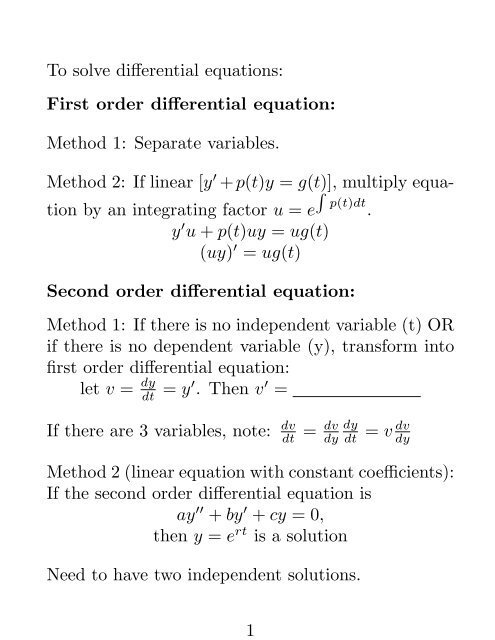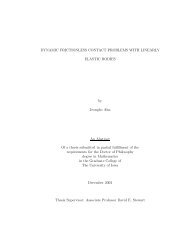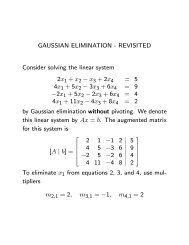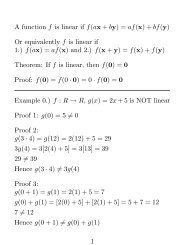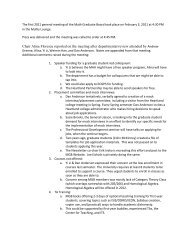To solve differential equations: First order differential equation ...
To solve differential equations: First order differential equation ...
To solve differential equations: First order differential equation ...
Create successful ePaper yourself
Turn your PDF publications into a flip-book with our unique Google optimized e-Paper software.
<strong>To</strong> <strong>solve</strong> <strong>differential</strong> <strong><strong>equation</strong>s</strong>:<br />
<strong>First</strong> <strong>order</strong> <strong>differential</strong> <strong>equation</strong>:<br />
Method 1: Separate variables.<br />
Method 2: If linear [y ′ + p(t)y = g(t)], multiply <strong>equation</strong><br />
by an integrating factor u = e<br />
p(t)dt.<br />
y ′ u + p(t)uy = ug(t)<br />
(uy) ′ = ug(t)<br />
Second <strong>order</strong> <strong>differential</strong> <strong>equation</strong>:<br />
Method 1: If there is no independent variable (t) OR<br />
if there is no dependent variable (y), transform into<br />
first <strong>order</strong> <strong>differential</strong> <strong>equation</strong>:<br />
let v = dy<br />
dt = y′ . Then v ′ =<br />
If there are 3 variables, note: dv<br />
dt<br />
= dv<br />
dy<br />
dy<br />
dt<br />
= v dv<br />
dy<br />
Method 2 (linear <strong>equation</strong> with constant coefficients):<br />
If the second <strong>order</strong> <strong>differential</strong> <strong>equation</strong> is<br />
ay ′′ + by ′ + cy = 0,<br />
then y = e rt is a solution<br />
Need to have two independent solutions.<br />
1
ay ′′ + by ′ + cy = 0, y = e rt , then<br />
ar 2 e rt + bre rt + ce rt = 0 implies ar 2 + br + c = 0,<br />
Suppose r = r1, r2 are solutions to ar 2 + br + c = 0<br />
If r1 = r2, then b 2 −4ac = 0. Hence a general solution<br />
is y = c1e r1t + c2e r2t<br />
If b 2 − 4ac > 0, general solution is y = c1e r1t + c2e r2t .<br />
If b 2 −4ac < 0, change format to linear combination of<br />
real-valued functions instead of complex valued functions<br />
by using Euler’s formula.<br />
general solution is y = c1e dt cos(nt) + c2e dt sin(nt)<br />
where r = d ± in<br />
If b 2 − 4ac = 0, r1 = r2, so need 2nd (independent)<br />
solution: te r1t<br />
Hence general solution is y = c1e r1t + c2te r1t .<br />
Initial value problem: use y(0) = y0, y ′ (0) = y ′ 0 to<br />
<strong>solve</strong> for c1, c2 to find unique solution.<br />
2
Derivation of general solutions:<br />
If b 2 − 4ac > 0 we guessed e rt is a solution and noted<br />
that any linear combination of solutions is a solution<br />
to a homogeneous linear <strong>differential</strong> <strong>equation</strong>.<br />
If b 2 − 4ac < 0, :<br />
Changed format of y = c1e r1t + c2e r2t to linear combination<br />
of real-valued functions instead of complex<br />
valued functions by using Euler’s formula:<br />
e it = cos(t) + isin(t)<br />
Hence e (d+in)t = e dt e int = e dt [cos(nt) + isin(nt)]<br />
Let r1 = d + in, r2 = d − in<br />
y = c1e r1t + c2e r2t<br />
= c1e dt [cos(nt)+isin(nt)]+c2e dt [cos(−nt)+isin(−nt)]<br />
= c1e dt cos(nt)+ic1e dt sin(nt)+c2e dt cos(nt)−ic2e dt sin(nt)<br />
=(c1 + c2)e dt cos(nt) + i(c1 − c2)e dt sin(nt)<br />
= k1e dt cos(nt) + k2e dt sin(nt)<br />
3
If b 2 − 4ac = 0, then r1 = r2.<br />
Hence one solution is y = e r1t Need second solution.<br />
If y = e rt is a solution, y = ce rt is a solution.<br />
How about y = v(t)e rt ?<br />
y ′ = v ′ (t)e rt + v(t)re rt<br />
y ′′ = v ′′ (t)e rt + v ′ (t)re rt + v ′ (t)re rt + v(t)r 2 e rt<br />
= v ′′ (t)e rt + 2v ′ (t)re rt + v(t)r 2 e rt<br />
ay ′′ + by ′ + cy = 0<br />
a(v ′′ (t)e rt +2v ′ (t)re rt +v(t)r 2 e rt )+b(v ′ (t)e rt +v(t)re rt )+<br />
c(v(t)e rt ) = 0<br />
a(v ′′ (t)+2v ′ (t)r+v(t)r 2 )+b(v ′ (t)+v(t)r)+cv(t) = 0<br />
av ′′ (t)+2av ′ (t)r +av(t)r 2 +bv ′ (t)+bv(t)r +cv(t) = 0<br />
av ′′ (t) + (2ar + b)v ′ (t) + (ar 2 + br + c)v(t) = 0<br />
av ′′ (t) + (2a( −b<br />
2a ) + b)v′ (t) + 0 = 0<br />
Since ar 2 + br + c = 0 and r = −b<br />
2a<br />
4
av ′′ (t) + (−b + b)v ′ (t) = 0<br />
av ′′ (t) = 0<br />
Hence v ′′ (t) = 0<br />
v ′ (t) = k1<br />
v(t) = k1t + k2<br />
Hence v(t)e r1t = (k1t + k2)e r1t is a soln<br />
Hence te r1t is a nice second solution.<br />
Hence general solution is y = c1e r1t + c2te r1t<br />
3.6 Nonhomogeneous Equations: ay ′′ +by ′ +cy = g(t)<br />
Method of Undetermined Coefficients.<br />
5


